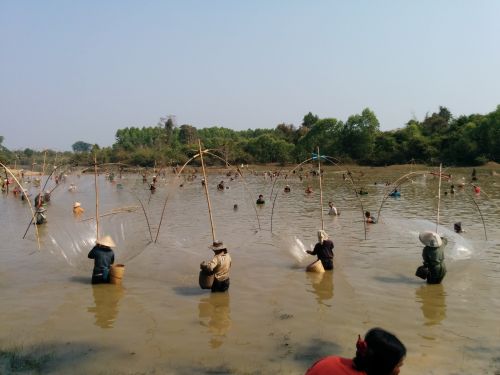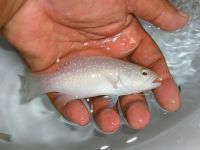Culture-based Fisheries Development in Lao PDR and Cambodia
1 November 2016 | 4565 views | Culture-based fisheries, Inland aquaculture, Livelihoods, gender and social issues, Environment and Sustainability

The objectives of this project are i) to introduce culture-based fisheries (CBF) to Cambodia and ii) to consolidate the gains of communities that have adopted CBF in Lao PDR. The project is developing strategies to improve the benefits of CBF under varying social, climatic and governance regimes.
Culture-based fisheries are a useful development strategy for improving the income and food security of rural communities. CBF requires minimal capital outlay, mobilising farming communities to make use of existing small dams and reservoirs for the secondary purpose of foodfish production. Fish growth is driven by natural productivity with no requirement for feeding. Generally, local communities have collective ownership of the stock and the benefits are shared or used for communal purposes.
The project is currently in its second phase (June 2015 - December 2016), focussing solely on Cambodia. The first phase of the project (June 2012 - December 2014) also operated in Lao PDR.
Research issues
- How the economic viability of CBF practices could be improved.
- Could a communication system that would encourage exchange of information among communities be utilised effectively for improving CBF management practices and marketing issues confronting rural communities.
- Developing protocols for artificial propagation and larva-to-fingerling rearing and science-based broodstock management plans for indigenous species, with a long-term view (regionally) to encourage a shift to aquaculture of indigenous species.
In Cambodia, where CBF has not been previously practiced, the research issues are:
- Identifying the suitability of water bodies in six provinces for CBF.
- Developing suitable yield-prediction models for estimation of potential yields in small water bodies in relation to limnological and catchment parameters.
- Determining the most suitable species combinations and management procedures for CBF through growth trials over two cycles.
- Optimisation of CBF yields within the framework of an open access fisheries regime through modifications to practices, utilising designated conservation zones in water bodies as a nursery area.
Impact
Lao PDR
- CBF practices were introduced to twelve additional communities, building on a previous project. In almost all instances there has been a gradual increase in in both production and income generated per hectare per cycle, as communities gained experience. Communities have continued to sustain CBF under their own funds and initiative following the end of project support, using the proceeds from harvest to fund stocking of the next crop. CBF practices have in many cases been adopted by neighbouring villages that were not part of the project and are spreading organically throughout the country.
- Funding generated from CBF has led to meaningful improvements to community infrastructure, such as the connection of a village school to the electricity grid In Thonwan Reservoir, Pakxan district, establishment of a piped water supply and improvements to irrigation reservoirs and canals.
- Better management practices for CBF have been developed based on an analysis of practices in Lao PDR and feedback from participating communities. A model for determining the potential stocking densities to be used for CBF activities in Cambodian reservoirs has also been developed. The findings, which will help to optimise returns from CBF, will be published in a forthcoming technical manual (currently in development).
- Community Communications Centres were established in eight locations, mainly in district or provincial government offices, which serve as primary extension points for surrounding communities. Weekly meetings of community leaders and extension personnel are held weekly for crop cycle planning, troubleshooting and sharing of experience.
- Community leaders engaged in CBF activities in Lao PDR (Hong Thong and Keo) have been regularly invited to attend the National Fisheries Co-management meetings since September 2013 and the bi-annual Fisheries Progress Meetings, where they share experience and contribute to the adoption of CBF practices elsewhere in the country.
Cambodia
- 23 reservoirs have been stocked in Cambodia with monitoring conducted on a monthly basis. Early feedback from stakeholder communities indicates a high level of satisfaction; in all cases the total monthly fish landings have increased substantially over pre-CBF levels.
- As fishing in inland waters is open access under Cambodian law, the project is trialling the nursing of seed in conservation zones to protect them from fishing for a period and increase returns. Some communities have voluntarily suspended fishing for up to six months of the year in order to give the stocked fish time to grow.
Joint
- Significant gains in capacity building have been made under the project. Bi-directional exchange visits of community leaders and government personnel have been conducted between Lao PDR and Cambodia. These provided Cambodian participants with the opportunity to discuss the experience of Lao counterparts who now have six years of progress in both technical and social organisation aspects of community-based CBF. Personnel in both countries are now contributing to the improvement of project activities.
- A Regional consultation on culture-based fisheries developments in Asia was held from 21-23 October in Cambodia; the proceedings are available as a publication Perspectives on culture-based fisheries developments in Asia.
- A technical manual Guidelines for hatchery production of of Pa Phia fingerlings in Lao PDR has been developed under the project. Pa Phia (Labeo chrysophekadion) is an important indigenous fish species that is a candidate for stocking in CBF programmes.
News archive
- Regional consultation on culture-based fisheries developments in Asia (3/11/2014)
- Culture-based fisheries exchange visit from Lao PDR to Cambodia (1/7/2014)
- Culture-based fisheries development in Lao PDR and Cambodia proceeding well (31/10/2013)
- Culture-based fisheries exchanges between Lao PDR and Cambodia (16/7/2013)
Publications
- Anon. (2015). Summary of culture-based fisheries developments in Lao PDR. In: Sena S. De Silva, B.A. Ingram and S. Wilkinson (eds.), Perspectives on culture-based fisheries developments in Asia, pp 53-57. Network of Aquaculture Centres in Asia-Pacific, Bangkok, Thailand.
- De Silva, S.S. and Song, S.L. (2015). Challenges and constraints for developing CBF in Cambodia and a possible strategy for success. In: Sena S. De Silva, B.A. Ingram and S. Wilkinson (eds.), Perspectives on culture-based fisheries developments in Asia, pp 53-57. Network of Aquaculture Centres in Asia-Pacific, Bangkok, Thailand.
- De Silva, S.S., Ingram, B.A. and Wilkinson, S. (eds.) (2015). Perspectives on culture-based fisheries developments in Asia. NACA Monograph Series No. 3, 126p.
- Phomsouvanh, A., Saphakdy, B. and De Silva, S.S. (2015). Production trends, monetary returns and benefit sharing protocols from the extensive aquaculture practice of culture-based fisheries in rural communities in Lao PDR. Aquaculture 439: 29-38.
- Ingram, B.A., Chanthavong, K., Nanthalath, T. and De Silva, S.S. (2014). Guidelines for hatchery production of Pha Phia fingerlings in Lao PDR. Fisheries Victoria Internal Report Series No. 17, 32p.
- Limsong, S., Sitha, H., Vutha, O., Mohan, C.V. and De Silva, S.S. (2013). Introduction of culture based fishery practices in small water bodies in Cambodia: issues and strategies. Aquaculture Asia Magazine, Vol. XVIII(4): 12-17.
Partners
- Department of Livestock and Fisheries, Vientiane, Lao PDR
- Fisheries Administration, Phnom Penh, Cambodia
- Deakin University, Australia
- Fisheries Victoria, Department of Primary Industries, Australia
Funding agency
This project is funded by the Australian Centre for International Agricultural Research.
Creative Commons Attribution.
